List of cities in the United Kingdom facts for kids
This is a list of cities in the United Kingdom that are officially designated such as of 12 November 2022[update]. It lists those places that have been granted city status by letters patent or royal charter.
There are currently a total of 76 such cities in the United Kingdom: 55 in England, eight in Scotland, seven in Wales, and six in Northern Ireland. Of these, 24 in England, two in Wales, and two in Northern Ireland have Lord Mayors; four in Scotland have Lord Provosts. In some cases, the area holding city status does not coincide with the built up area or conurbation of which it forms part. In Greater London, for example, the City of London and that of Westminster each hold city status separately, but no other local authority in the London Region has been granted city status, nor has the Greater London Authority.
In other cases, such as the cities of Canterbury and Lancaster, the status applies to a local government district which extends over a number of towns and rural areas outside the main settlement proper. In England, the status sometimes applies to civil parishes, such as the city of Ripon; though the status may not apply to the local government district which share their name. For example, the civil parishes of Lichfield and Chichester each hold city status, but the Lichfield District and the Chichester District, in which they are situated, respectively, do not.
The list does not include places like Luton or Northampton which, despite having populations of over 200,000, have not been awarded city status and thus formally remain as towns. As of 2022, there are currently 5 ceremonial counties which contain 3 cities – Cambridgeshire, Essex, Hampshire, West Midlands and West Yorkshire. Outside the UK within British overseas cities of the British Overseas Territories and Crown Dependencies, there are currently five. The number has increased as part of the Platinum Jubilee celebrations, with longstanding cities Gibraltar, Hamilton in Bermuda and Jamestown in St Helena being joined by Stanley in the Falkland Islands and Douglas in the Isle of Man.
Contents
History
The initial cities (Latin: civitas) of Britain were the fortified settlements organised by the Romans as the capitals of the Celtic tribes under Roman rule. The British clerics of the early Middle Ages later preserved a traditional list of the "28 Cities" (Old Welsh: cair) which was mentioned by Gildas and listed by Nennius.
The title of city was initially informal and, into the 20th century, royal charters were considered to recognise city status rather than to grant it. The usual criterion in early modern Britain was the presence of a cathedral, particularly after King Henry VIII granted letters patent establishing six new cities when he established a series of new dioceses in the 1540s as part of the English Reformation. No new cities were created between the 16th and 19th centuries, but following the Industrial Revolution and the accompanying population boom and growth in urbanisation, new sees were established at Ripon (1836) and Manchester (1847); their councils began to style them cities immediately. Inverness in Scotland was even refused a charter at the time of the Jubilee honours of 1897, in part because it would have drawn more attention to the other traditional "cities" still not formally chartered as such.
Beginning in the mid-19th century, however, the process became more formal. A visit by Queen Victoria in 1851 prompted Manchester to petition Parliament for recognition of its status. Ripon followed in the 1860s, and a series of hitherto informal "cities" were formally recognised in the 1880s and 1890s. On the basis of its size, importance, and regular government, Belfast was elevated in spite of its lack of a cathedral in 1888; other large municipalities followed, while smaller applicants began to be rejected. King Edward VII and the Home Office established three criteria for future applicants in 1907—a minimum population of 300,000, a good record of local government, and a "local metropolitan character" – but these criteria were not made public, and following Leicester's successful elevation in 1919 a series of exceptions were made. The 1972 Local Government Act effectively eliminated all authorities holding city status outside Greater London on 1 April 1974; most of their replacements were confirmed in their predecessor's status—even in cases such as the 1974–2023 City of Carlisle district, where much of the local authority area was undeveloped countryside—but the Borough of Medway was not permitted to continue Rochester's title. In recent times there have been competitions for new grants of city status. Towns or councils that claim city status or add "city" to their name have been known to be rebuked by the Advertising Standards Authority.
The cities of Scotland and Ireland were treated separately. Scottish towns irregularly applied the description to themselves, but were formally organised as royal burghs; the special rights of these were preserved by Article XXI of the Treaty of Union which established the single state of Great Britain in 1707. Edinburgh and Glasgow were confirmed as cities "by ancient usage" in the 18th century, as was Aberdeen, and this was later reconfirmed in the Act enlarging the burgh in 1891. Dundee was granted letters patent in 1889 and Elgin and Perth were recognised as cities by the Home Office in 1972, before the privilege was removed by the Scottish Local Government Act of 1973. In Ireland, only the seat of the primate at Armagh was accorded city status by ancient usage, and this status was abolished by the Irish Municipal Corporations Act of 1840. All other cities have been those explicitly recognised as such.
Statistical role
City status has no significance in UK statistically because it is not a measure of a city's size and only holds a ceremonial status. Historic cities, such as St Davids (a cathedral city in Wales) can be quite small, however newer cities, such as those conferred in 2022, can range in size from anywhere between 50,000 to over 200,000. There are large populous settlements, such as Luton, Northampton and Reading, that still do not have city status.
Conurbations
The term "city" is sometimes loosely applied to conurbations in the UK. The government tends to recognise these as primary urban areas for statistical and economic purposes, though greater urban areas are what most determine to be a city region. Large cities outside of London such as Manchester or Birmingham are often confused with these greater conurbations. According to the 2011 census, Manchester was significantly less populous than Birmingham, despite Greater Manchester having a larger urban population than the West Midlands conurbation. This question of definition has provoked a second city debate in the United Kingdom.
Conversely, many official cities in the UK contain a substantial rural area encompassing settlements which are physically separated from the core urban area. This applies to settlements such as Milton Keynes and Colchester, whose local authorities received Letters Patent, despite the City of Milton Keynes and City of Colchester administrative units covering an area substantially larger than that of their respective core urban areas, meaning that extra-urban settlements such as Olney and West Mersea fall within de jure cities.
List of cities
| Image | De facto | De jure | ||||
|---|---|---|---|---|---|---|
| City | Region, Country | Year granted or confirmed |
City | City council status | Population | |
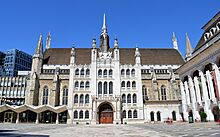 |
London | London, England | time immemorial | City of London | LGD (sui generis and ceremonial county) |
12,156 (2023) |
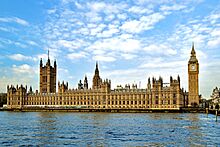 |
Westminster | London, England | 1,540 | City of Westminster | LGD (London borough) |
213,119 (2023) |
 |
Birmingham | West Midlands, England | 1,889 | City of Birmingham | LGD (Metropolitan borough) |
1,171,467 (2023) |
 |
Leeds | Yorkshire and the Humber, England | 1,893 | City of Leeds | LGD (Metropolitan borough) |
829,417 (2023) |
 |
Glasgow (Scots: Glesga) (Scottish Gaelic: Glaschu) |
Scotland | 18th century (Burgh: 1492) |
Glasgow | LGD (Council area) |
620,700 (2022) |
 |
Manchester | North West, England | 1,853 | City of Manchester | LGD (Metropolitan borough) |
585,057 (2023) |
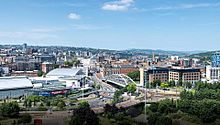 |
Sheffield | Yorkshire and the Humber, England | 1,893 | City of Sheffield | LGD (Metropolitan borough) |
579,082 (2023) |
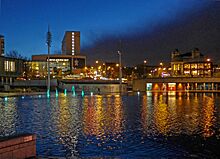 |
Bradford | Yorkshire and the Humber, England | 1,897 | City of Bradford | LGD (Metropolitan borough) |
556,880 (2023) |
 |
Edinburgh (Scottish Gaelic: Dùn Èideann) |
Scotland | 18th century (Burgh: 1329) |
Edinburgh | LGD (Council area) |
512,700 (2022) |
 |
Liverpool | North West, England | 1,880 | City of Liverpool | LGD (Metropolitan borough) |
504,932 (2023) |
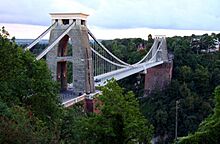 |
Bristol | South West, England | 1,542 | City of Bristol | LGD (Unitary and county) |
482,815 (2023) |
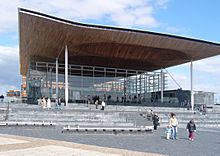 |
Cardiff (Welsh: Caerdydd) |
Wales | 1,905 | Cardiff | LGD (Principal area) |
381,759 (2023) |
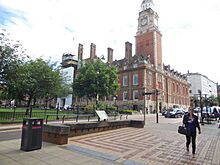 |
Leicester | East Midlands, England | 1,919 | City of Leicester | LGD (Unitary) |
379,963 (2023) |
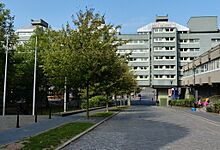 |
Coventry | West Midlands, England | 1,102
(time immemorial) |
City of Coventry | LGD (Metropolitan borough) |
368,483 (2023) |
 |
Wakefield | Yorkshire and the Humber, England | 1,888 | City of Wakefield | LGD (Metropolitan borough) |
362,355 (2023) |
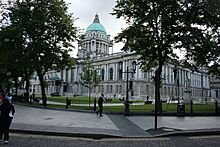 |
Belfast (Irish: Béal Feirste) (Ulster-Scots: Bilfawst) |
Northern Ireland | 1,888 | Belfast | LGD |
345,418 (2021) |
 |
Nottingham | East Midlands, England | 1,897 | City of Nottingham | LGD (Unitary) |
330,949 (2023) |
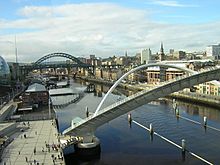 |
Newcastle upon Tyne | North East, England | 1,882 | City of Newcastle upon Tyne | LGD (Metropolitan borough) |
315,110 (2023) |
 |
Doncaster | Yorkshire and the Humber, England |
2,022 | City of Doncaster | LGD (Metropolitan borough) |
314,252 (2023) |
 |
Milton Keynes | South East, England | 2,022 | City of Milton Keynes | LGD (Unitary) |
297,180 (2023) |
 |
Salford | North West, England | 1,926 | City of Salford | LGD (Metropolitan borough) |
282,487 (2023) |
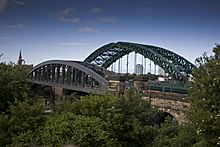 |
Sunderland | North East, England | 1,992 | City of Sunderland | LGD (Metropolitan borough) |
279,556 (2023) |
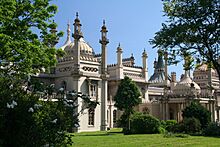 |
Brighton and Hove | South East, England | 2,001 | Brighton and Hove | LGD (Unitary) |
278,455 (2023) |
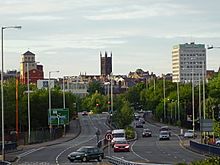 |
Wolverhampton | West Midlands, England | 2,001 | City of Wolverhampton | LGD (Metropolitan borough) |
271,173 (2023) |
 |
Kingston upon Hull | Yorkshire and the Humber, England | 1,897 | City of Kingston upon Hull | LGD (Unitary) |
271,095 (2023) |
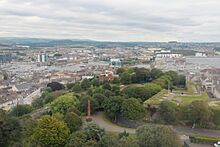 |
Plymouth | South West, England | 1,928 | City of Plymouth | LGD (Unitary) |
267,888 (2023) |
 |
Derby | East Midlands, England | 1,977 | City of Derby | LGD (Unitary) |
265,082 (2023) |
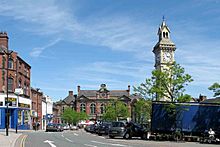 |
Stoke-on-Trent | West Midlands, England | 1,925 | City of Stoke-on-Trent | LGD (Unitary) |
261,867 (2023) |
 |
Southampton | South East, England | 1,964 | City of Southampton | LGD (Unitary) |
257,160 (2023) |
 |
Swansea (Welsh: Abertawe) |
Wales | 1,969 | Swansea | LGD (Principal area) |
245,440 (2023) |
 |
Aberdeen (Scots: Aiberdeen) (Scottish Gaelic: Obar Dheathain) |
Scotland | 1891 (Burgh: 1179) |
Aberdeen | LGD (Council area) |
224,000 (2022) |
 |
Peterborough | East, England | 1,541 | City of Peterborough | LGD (Unitary) |
218,179 (2023) |
 |
Portsmouth | South East, England | 1,926 | City of Portsmouth | LGD (Unitary) |
209,171 (2023) |
 |
York | Yorkshire and the Humber, England | time immemorial | City of York, | LGD (Unitary) |
206,825 (2023) |
 |
Colchester | East, England | 2,022 | City of Colchester | LGD (Non-metropolitan borough) |
196,808 (2023) |
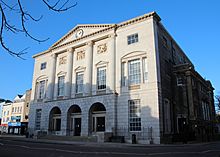 |
Chelmsford | East, England | 2,012 | City of Chelmsford | LGD (Non-metropolitan borough) |
185,288 (2023) |
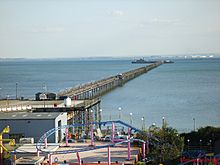 |
Southend-on-Sea | East, England | 2,022 | City of Southend-on-Sea | LGD (Unitary) |
182,278 (2023) |
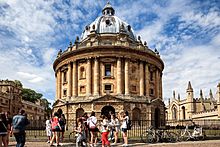 |
Oxford | South East, England | 1,542 | City of Oxford | LGD (Non-metropolitan borough) |
165,257 (2023) |
 |
Newport
(Welsh: Casnewydd) |
Wales | 2,002 | Newport | LGD (Principal area) |
163,547 (2023) |
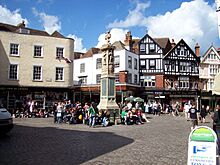 |
Canterbury | South East, England | time immemorial | City of Canterbury | LGD (Non-metropolitan borough) |
160,351 (2023) |
 |
Preston | North West, England | 2,002 | City of Preston | LGD (Non-metropolitan borough) |
155,634 (2023) |
 |
Dundee (Scottish Gaelic: Dùn Dèagh) |
Scotland | 1889 (Burgh: 1191) |
Dundee | LGD (Council area) |
148,100 (2022) |
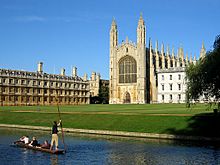 |
Cambridge | East, England | 1,951 | City of Cambridge | LGD (Non-metropolitan borough) |
147,797 (2023) |
 |
St Albans | East, England | 1,877 | St Albans City and District | LGD (Non-metropolitan borough) |
147,410 (2023) |
 |
Lancaster | North West, England | 1,937 | City of Lancaster | LGD (Non-metropolitan borough) |
145,346 (2023) |
 |
Norwich | East, England | 1,094
(time immemorial) |
City of Norwich | LGD (Non-metropolitan borough) |
144,251 (2023) |
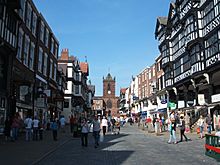 |
Chester | North West, England | 1,541 | (Cheshire West and Chester does not hold status) | Charter trustees |
138,873 (2021) |
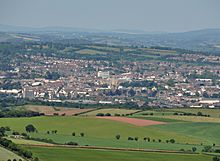 |
Exeter | South West, England | time immemorial | City of Exeter | LGD (Non-metropolitan borough) |
137,462 (2023) |
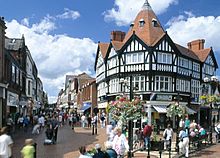 |
Wrexham (Welsh: Wrecsam) |
Wales | 2,022 | Wrexham County Borough | LGD (Principal area) |
137,341 (2023) |
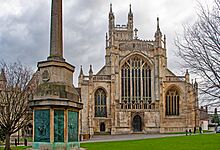 |
Gloucester | South West, England | 1,541 | City of Gloucester | LGD (Non-metropolitan borough) |
133,998 (2023) |
 |
Winchester | South East, England | time immemorial | City of Winchester | LGD (Non-metropolitan borough) |
132,341 (2023) |
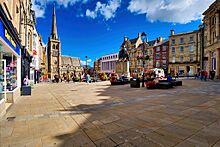 |
Durham | North East, England | time immemorial | (County Durham does not hold status) | Charter trustees |
126,486 (2021) |
 |
Carlisle | North West, England | 1,133 (time immemorial) | (Cumberland does not hold status) | Charter trustees | 110,024 (2021) |
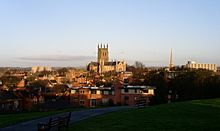 |
Worcester | West Midlands, England | time immemorial | City of Worcester | LGD (Non-metropolitan borough) |
104,589 (2023) |
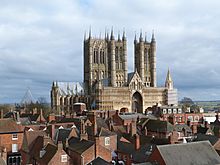 |
Lincoln | East Midlands, England | 1,072 (time immemorial) | City of Lincoln | LGD (Non-metropolitan borough) |
102,392 (2023) |
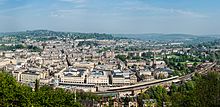 |
Bath | South West, England | 1,090 (time immemorial) | (Bath and North East Somerset does not hold status) | Charter trustees |
95,043 (2021) |
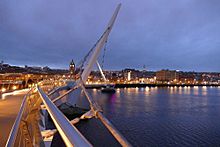 |
Derry (Irish: Doire) (Ulster-Scots: Derrie) |
Northern Ireland | 1,604 | None | Represented on Derry City and Strabane District Council |
85,279 (2021) |
 |
Dunfermline | Scotland | 2,022 | None | None | 76,210 (2020) |
 |
Bangor (Irish: Beannchar) |
Northern Ireland | 2,022 | None | Represented on Ards and North Down Borough Council | 64,596 (2021) |
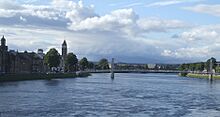 |
Inverness (Scots: Inerness) (Scottish Gaelic: Inbhir Nis) |
Scotland | 2,001 | None | None |
63,730 (2020) |
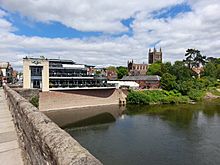 |
Hereford | West Midlands, England | time immemorial | Hereford parish | Civil parish |
53,113 (2021) |
 |
Lisburn (Irish: Lios na gCearrbhach) |
Northern Ireland | 2,002 | None | Represented on Lisburn and Castlereagh City Council |
51,447 (2021) |
 |
Stirling (Scots: Stirlin) (Scottish Gaelic: Sruighlea) |
Scotland | 2,002 | None | None |
49,950 (2020) |
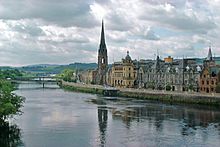 |
Perth (Scots: Pairth) (Scottish Gaelic: Peairt) |
Scotland | 2,012 (Burgh: 12th century) |
None | None |
47,350 (2020) |
 |
Salisbury | South West, England | 1,227 | Salisbury parish | Civil parish |
41,552 (2021) |
 |
Lichfield | West Midlands, England | time immemorial | Lichfield parish | Civil parish |
32,580 (2021) |
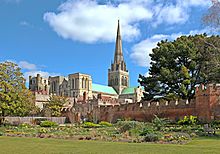 |
Chichester | South East, England | 1,075
(time immemorial) |
Chichester parish | Civil parish |
29,407 (2021) |
 |
Newry (Irish: Iúr Cinn Trá) (Ulster-Scots: Newrie) |
Northern Ireland | 2,002 | None | Represented on Newry, Mourne and Down District Council |
28,530 (2021) |
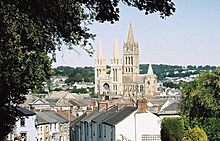 |
Truro (Cornish: Truru) |
South West, England | 1,877 | Truro parish | Civil parish |
21,046 (2021) |
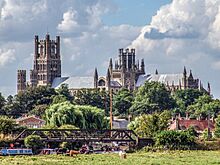 |
Ely | East, England | 1,109
(time immemorial) |
Ely parish | Civil parish |
20,574 (2021) |
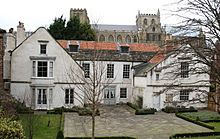 |
Ripon | Yorkshire and the Humber, England | 1,865 | Ripon parish | Civil parish |
16,590 (2021) |
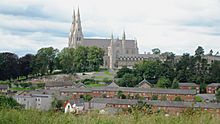 |
Armagh (Irish: Ard Mhacha) (Ulster-Scots: Airmagh) |
Northern Ireland | 1,994 | None | Represented on Armagh City, Banbridge and Craigavon Borough Council |
16,310 (2021) |
 |
Bangor | Wales | time immemorial | Bangor community | Community |
15,060 (2021) |
 |
Wells | South West, England | time immemorial | Wells parish | Civil parish |
11,145 (2021) |
 |
St Asaph (Welsh: Llanelwy) |
Wales | 2,012 | St Asaph community | Community |
3,485 (2021) |
 |
St Davids (Welsh: Tyddewi) |
Wales | 1,994 | St Davids and the Cathedral Close | Community |
1,751 (2021) |
Map of the cities
Below is a map of the 76 cities in the United Kingdom of Great Britain and Northern Ireland. Also shown is the one city in a UK Crown Dependency, Douglas in the Isle of Man. (For cities in UK Overseas Territories, see below.)
32 cities have a Lord Provost (in Scotland) or a Lord Mayor (in England, Wales, and Northern Ireland), see List of lord mayoralties and lord provostships in the United Kingdom.
The six cities where the Lord Mayor or Lord Provost has the right to the style The Right Honourable are York, the City of London, Edinburgh, Glasgow (since 1912), Belfast (since 1923), and Cardiff (since 1956).
| Map | Key |
|---|---|
| <mapframe longitude="-3.2" latitude="54.5" zoom="5" width="325" height="450" frameless align="center">
[ { "type": "ExternalData", "service": "geoshape", "query": "SELECT DISTINCT ?id ?idLabel ?countylabel\n ( 0 as ?fill_opacity)\n ( 3 as ?stroke_width) \n (?countylabel as ?title)\nWHERE\n{\n?id rdfs:label ?countylabel.\n FILTER(LANG(?countylabel) = \"en\") #only eng county labels\n FILTER ( ?id not in ( wd:Q19186 , wd:Q929902 ))\n { # SERVICE wikibase:label { bd:serviceParam wikibase:language \"[AUTO_LANGUAGE]\". }\n {\n { ?id p:P31 ?statement0. ?statement0 (ps:P31/(wdt:P279*)) wd:Q180673. } # eng counties\n UNION\n { ?id p:P31 ?statement1. ?statement1 (ps:P31/(wdt:P279*)) wd:Q15060255. } #scot areas\n UNION\n { ?id p:P31 ?statement2. ?statement2 (ps:P31/(wdt:P279*)) wd:Q1317848. } # NI counties\n UNION \n { ?id p:P31 ?statement5. ?statement5 (ps:P31/(wdt:P279*)) wd:Q15979307. } #wales principal \n UNION {?id p:P131 ?newport. ?newport (ps:P131) wd:Q5283458. ?id p:P31 ?newport2. ?newport2 (ps:P31) wd:Q515.} \n UNION {?id p:P131 ?scot. ?scot (ps:P131) wd:Q22. ?id p:P31 ?scot2. ?scot2 (ps:P31) wd:Q515.} \n # MINUS { ?id p:P31 ?statement3. ?statement3 (ps:P31/(wdt:P279*)) wd:Q19953632. } #former admin areas (needed for scotland)\n # OPTIONAL {?link schema:about ?id . ?link schema:isPartOf <https://en.wikipedia.org/> . } # url of webpage\n # BIND(COALESCE(concat('', ?countylabel, ''), (concat('', ?countylabel, ''))) AS ?link2)\n }\n }\n }\n LIMIT 200" }, { "type": "ExternalData", "service": "geoshape", "query": "SELECT DISTINCT ?id ?idLabel \n(\"#ff0000\" AS ?fill) \n( 0.3 AS ?fill_opacity)\n( 1 AS ?stroke_width)\n(\"#ff0000\" AS ?stroke)\n(0.7 AS ?stroke_opacity)\nWHERE\n{ # SERVICE wikibase:label { bd:serviceParam wikibase:language \"[AUTO_LANGUAGE]\". }\n {?id rdfs:label ?idLabel.}\n FILTER( LANG(?idLabel)=\"en\" )\n FILTER (?id != wd:Q84)\n FILTER (?id != wd:Q1094110)\n FILTER (?id != wd:Q23154)\n FILTER (?id != wd:Q6226)\n FILTER (?id != wd:Q193452)\n FILTER (?id != wd:Q22889) \n FILTER (?id != wd:Q269980)\n { ?id p:P31 ?statement0. ?statement0 (ps:P31) wd:Q515. }\n UNION\n { ?id p:P31 ?statement1. ?statement1 (ps:P31) wd:Q27104997. }\n UNION\n { ?id p:P31 ?statement2. ?statement2 (ps:P31) wd:Q21503295. }\n UNION {?id p:P131 ?newport. ?newport (ps:P131) wd:Q11294004. ?id p:P31 ?newport2. ?newport2 (ps:P31) wd:Q515.} { ?id p:P17 ?statement3. ?statement3 (ps:P17) wd:Q145. }\n}\n LIMIT 300" }, { "type": "ExternalData", "service": "geopoint", "query": "SELECT DISTINCT ?id ?placelabel ?geo\n(?img as ?img_)\n(\"-number\" AS ?marker_symbol) \n(\"#ff0000\" AS ?marker_color)\n(concat('', ?placelabel, '') as ?title)\n(concat(, ) as ?description)\nWHERE { ?id wdt:P625 ?geo.\n# { SERVICE wikibase:label { bd:serviceParam wikibase:language \\\"[AUTO_LANGUAGE]\\\" . }\n?id rdfs:label ?placelabel .\nFILTER (LANG(?placelabel) = \"en\")\nFILTER (?id != wd:Q84) \nFILTER (?id != wd:Q27573903)\nFILTER (?id != wd:Q24341876)\nFILTER (?id != wd:Q843868) \n# FILTER (?id != wd:Q84) \n ?id p:P17 ?statement0. wd:Q145 ^ps:P17 ?statement0 .\n?id p:P31 ?statement1. wd:Q515 ^ps:P31 ?statement1.\nMINUS { ?id p:P31 ?statement2. wd:Q19953632 (^ps:P31/(^wdt:P279)) ?statement2.}\nOPTIONAL { ?id wdt:P18 ?img . }\n# OPTIONAL { ?id p:P31 ?body . ?body (ps:P31/(wdt:P1376)) wdt:Q21503295. }\nOPTIONAL {?link schema:about ?id . ?link schema:isPartOf <https://en.wikipedia.org/> . } #\n }\nORDER BY ASC(?placelabel) \nLIMIT 300" }, { "type": "ExternalData", "service": "page", "title": "Belfast-2.map" } ] </mapframe> |
|
Overseas Territories and Crown Dependencies
The UK Overseas Territories and UK Crown Dependencies do not form part of the United Kingdom. Association of city status with cathedrals ended in 1865. There are presently five cities in Overseas Territories and Crown Dependencies.
| Image | City | Year granted or confirmed |
Territory/Dependency | Status | Population (Census) |
|---|---|---|---|---|---|
 |
Gibraltar | 1842 | Gibraltar, southwestern Europe | British Overseas Territory | 32,194 (2012) |
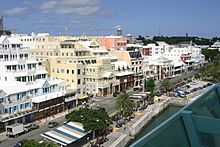 |
Hamilton | 1897 | Bermuda, North Atlantic Ocean |
British Overseas Territory | 854 (2016) |
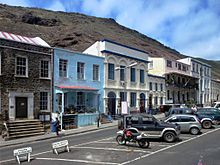 |
Jamestown | 1859 | St Helena, Ascension and Tristan da Cunha, South Atlantic Ocean |
British Overseas Territory | 629 (2016) |
 |
Stanley | 2022 | Falkland Islands, South Atlantic Ocean |
British Overseas Territory | 2,460 (2016) |
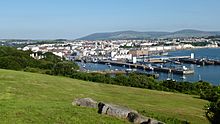 |
Douglas (Manx: Doolish) |
2022 | Isle of Man, Irish Sea |
Crown Dependency | 27,938 (2011) |
See also
- City status in the United Kingdom
- Centre for Cities
- List of lord mayoralties and lord provostships in the United Kingdom
- List of towns in the United Kingdom
- List of urban areas in the United Kingdom
- City status in Ireland
- List of smallest cities in the United Kingdom
- Royal burgh





